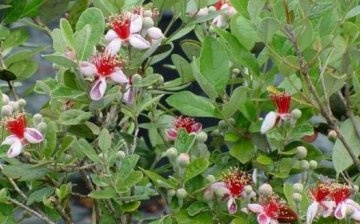Feijoa in the photo and features of its content
Feijoa in the photo is a prominent representative of the myrtle family, originating from South America (Paraguay, Uruguay, South Brazil, Northern Argentina). In the wild, it is an evergreen tree or shrub with a spreading dense crown.
Feijoa leaves are medium in size, oval, rather decorative: gray-green above and silvery below. Pale pink large flowers with many red stamens are very beautiful. Edible fruits are dark green berries with fragrant pulp and small seeds. Feijoa in the photo is grown in tubs or large pots, using mainly as a fruit and ornamental plant for winter garden compositions.
Feijoa likes partial shade or bright light. In winter, it requires additional lighting. The plant tolerates a short-term drop in temperature to zero, but at the same time it often sheds its leaves (partially).
Feijoa is watered abundantly from spring to autumn, moderately in winter, but the soil should not be allowed to dry out. Requires frequent spraying of the foliage. In the summer, it is advisable to regularly feed with organic fertilizers.
The plant is transplanted only in spring: young - once every couple of years, old - as needed. Reproduction is mainly by fresh seeds, planted in spring (at a temperature of + 20 + 22) in a moistened mixture of peat and sand. Can be propagated by air layers or cuttings.
Feijoa accumulates such an amount of iodine compounds that no plant is capable of, therefore, folk medicine uses feijoa fruits in the treatment of Graves' disease, gout, atherosclerosis, atonic constipation, and in the preparation of dietary meals.



